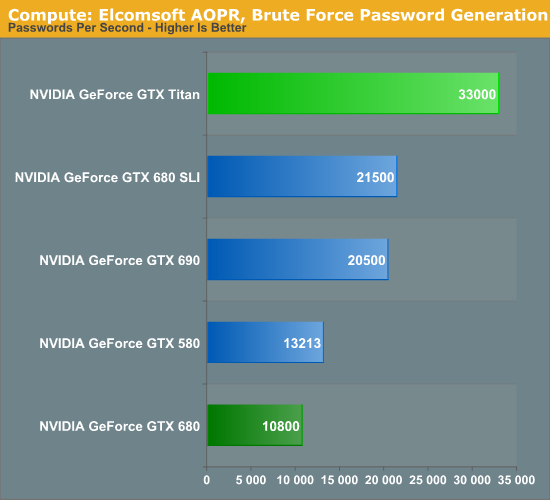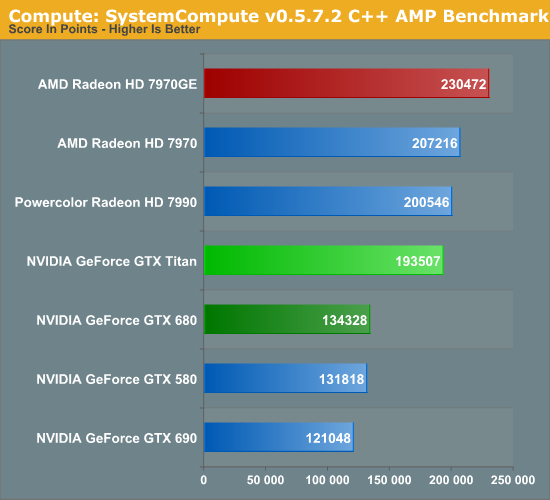NVIDIA’s GeForce GTX Titan Review, Part 2: Titan's Performance Unveiled
by Ryan Smith & Rahul Garg on February 21, 2013 9:00 AM ESTTitan’s Compute Performance, Cont
With Rahul having covered the basis of Titan’s strong compute performance, let’s shift gears a bit and take a look at real world usage.
On top of Rahul’s work with Titan, as part of our 2013 GPU benchmark suite we put together a larger number of compute benchmarks to try to cover real world usage, including the old standards of gaming usage (Civilization V) and ray tracing (LuxMark), along with several new tests. Unfortunately that got cut short when we discovered that OpenCL support is currently broken in the press drivers, which prevents us from using several of our tests. We still have our CUDA and DirectCompute benchmarks to look at, but a full look at Titan’s compute performance on our 2013 GPU benchmark suite will have to wait for another day.
For their part, NVIDIA of course already has OpenCL working on GK110 with Tesla. The issue is that somewhere between that and bringing up GK110 for Titan by integrating it into NVIDIA’s mainline GeForce drivers – specifically the new R314 branch – OpenCL support was broken. As a result we expect this will be fixed in short order, but it’s not something NVIDIA checked for ahead of the press launch of Titan, and it’s not something they could fix in time for today’s article.
Unfortunately this means that comparisons with Tahiti will be few and far between for now. Most significant cross-platform compute programs are OpenCL based rather than DirectCompute, so short of games and a couple other cases such as Ian’s C++ AMP benchmark, we don’t have too many cross-platform benchmarks to look at. With that out of the way, let’s dive into our condensed collection of compute benchmarks.
We’ll once more start with our DirectCompute game example, Civilization V, which uses DirectCompute to decompress textures on the fly. Civ V includes a sub-benchmark that exclusively tests the speed of their texture decompression algorithm by repeatedly decompressing the textures required for one of the game’s leader scenes. While DirectCompute is used in many games, this is one of the only games with a benchmark that can isolate the use of DirectCompute and its resulting performance.
Note that for 2013 we have changed the benchmark a bit, moving from using a single leader to using all of the leaders. As a result the reported numbers are higher, but they’re also not going to be comparable with this benchmark’s use from our 2012 datasets.

With Civilization V having launched in 2010, graphics cards have become significantly more powerful since then, far outpacing growth in the CPUs that feed them. As a result we’ve rather quickly drifted from being GPU bottlenecked to being CPU bottlenecked, as we see both in our Civ V game benchmarks and our DirectCompute benchmarks. For high-end GPUs the performance difference is rather minor; the gap between GTX 680 and Titan for example is 45fps, or just less than 10%. Still, it’s at least enough to get Titan past the 7970GE in this case.
Our second test is one of our new tests, utilizing Elcomsoft’s Advanced Office Password Recovery utility to take a look at GPU password generation. AOPR has separate CUDA and OpenCL kernels for NVIDIA and AMD cards respectively, which means it doesn’t follow the same code path on all GPUs but it is using an optimal path for each GPU it can handle. Unfortunately we’re having trouble getting it to recognize AMD 7900 series cards in this build, so we only have CUDA cards for the time being.

Password generation and other forms of brute force crypto is an area where the GTX 680 is particularly weak, thanks to the various compute aspects that have been stripped out in the name of efficiency. As a result it ends up below even the GTX 580 in these benchmarks, never mind AMD’s GCN cards. But with Titan/GK110 offering NVIDIA’s full compute performance, it rips through this task. In fact it more than doubles performance from both the GTX 680 and the GTX 580, indicating that the huge performance gains we’re seeing are coming from not just the additional function units, but from architectural optimizations and new instructions that improve overall efficiency and reduce the number of cycles needed to complete work on a password.
Altogether at 33K passwords/second Titan is not just faster than GTX 680, but it’s faster than GTX 690 and GTX 680 SLI, making this a test where one big GPU (and its full compute performance) is better than two smaller GPUs. It will be interesting to see where the 7970 GHz Edition and other Tahiti cards place in this test once we can get them up and running.
Our final test in our abbreviated compute benchmark suite is our very own Dr. Ian Cutress’s SystemCompute benchmark, which is a collection of several different fundamental compute algorithms. Rahul went into greater detail on this back in his look at Titan’s compute performance, but I wanted to go over it again quickly with the full lineup of cards we’ve tested.

Surprisingly, for all of its performance gains relative to GTX 680, Titan still falls notably behind the 7970GE here. Given Titan’s theoretical performance and the fundamental nature of this test we would have expected it to do better. But without additional cross-platform tests it’s hard to say whether this is something where AMD’s GCN architecture continues to shine over Kepler, or if perhaps it’s a weakness in NVIDIA’s current DirectCompute implementation for GK110. Time will tell on this one, but in the meantime this is the first solid sign that Tahiti may be more of a match for GK110 than it’s typically given credit for.










337 Comments
View All Comments
veppers - Saturday, February 23, 2013 - link
Grow up man.CeriseCogburn - Saturday, February 23, 2013 - link
Adults like myself face reality. Lying fanboys act like spoiled brats and cannot stand to hear or see the truth.You're a child.
Alucard291 - Sunday, February 24, 2013 - link
Yup and you sound just like the spoilt brat in question. This is not engadget mate. Go away.CeriseCogburn - Sunday, February 24, 2013 - link
So far you've posted 3 attacks against me, and added exactly NOTHING to any discussion here.It's clear you're the whining troll with nothing to say, so you are one that needs to go away, right ? Right.
chizow - Monday, February 25, 2013 - link
Oh the irony, you are crying about posting personal attacks and adding nothing to any discussion here? That's what every single one of your posts boils down to.Alucard291 - Friday, March 8, 2013 - link
The discussion? You spew random offensive insulting nonsense against anyone who dares to point out that slower + more expensive is worse than faster and cheaper (be it amd or nv).You then proceed to attack people (on a very personal level I might add) for whatever other reason and go on to say that AMD (did anyone except you even mention amd? - well I'm sure some did but mostly due to your constant stream of butthurt) is terrible.
Cool don't use them. Calm down, relax, take a breather go for a walk.
Or of course you can continue whiteknighting some random product that you are unlikely (given the odds) to ever buy for yourself. Who cares. Just get off the neophyte train when you do it. Ok?
CeriseCogburn - Tuesday, March 12, 2013 - link
You have no clue on any odds.Like I said, you people are 3rd worlder crybabies.
Between bragging hardcore upper end users frequent Anandtech, you whine and cry about 1/3rd the price of a decent PC.
You're all full of it, and all act like you're budget is personal malaria in sub saharan Africa, except of course when you're rig bragging.
This is the USA, except of course wherever you penniless paupers reside.
RussianSensation - Thursday, February 21, 2013 - link
Yes, yes. Keep eating NV's marketing. 36-38% faster than a $430 HD7970GE for $1000???!!http://www.computerbase.de/artikel/grafikkarten/20...
Heck, you can buy a $500 Asus Matrix Platinum 7970 and those overclock to 1300mhz, which makes the Matrix 30% faster than the GTX680. Do the math and see where that ends up relative to the Titan.
http://www.hardwarecanucks.com/forum/hardware-canu...
This is really a $699 card max.
CeriseCogburn - Saturday, February 23, 2013 - link
Why buy a crashing piece of crap amd cannot even write drivers for ?Forget it.
AMD is almost gone too, so "future proof" is nowhere except in nVidia's pocket.
Now and in the future, nVidia wins period.
Idiots buy amd.
Hrel - Thursday, February 21, 2013 - link
The problem with that reasoning, that they're raising here, is that the 7970 is almost as fast and costs a lot less. The Titan is competing, based on performance, with the 7970. Based on that comparison it's a shitty deal.http://www.newegg.com/Product/Product.aspx?Item=N8...
$430. So based on that I'd say the highest price you can justify for this card is $560. We'll round up to $600.
Nvidia shipping this, at this price, and just saying "it's a luxury product" is bullshit. It's not a luxury product, it's their version of a 7970GHE. But they want to try and get a ridiculous profit to support their PhysX and CUDA projects.
Nvidia just lost me as a customer. This is the last straw. This card should be pushing the pricing down on the rest of their lineup. They SHOULD be introducing it to compete with the 7970GHE. Even at my price range, compare the GTX660 to the 7870GHE, or better yet the sub $200 7850. They just aren't competitive anymore. I'll admit, I was a bit of a Nvidia fan boy. Loved their products. Was disappointed by older ATI cards and issues I had with them. (stability, screen fitting properly, audio issues) But ATI has become AMD and they've improved quality a lot and Nvidia is USING their customers loyalty; that's just wrong.
I'm done with Nvidia on the desktop. By the time I need a new laptop AMD will probably have the graphics switching all sorted; so I'm probably done with Nvidia on laptops too.